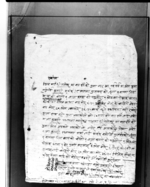A darkhāsta from Vimalāramaṇa Rājopādhyā to the Guṭhī Bandobasta Aḍḍā requesting material provisions for installing a new Kumārī (VS 1980)
ID: K_0214_0044
Edited and
translated by Astrid Zotter
in collaboration with
Raju Rimal
Created: 2018-10-15-;
Last modified: 2019-04-10
For the metadata of the document, click here
The accompanying edition, translation/synopsis and/or commentary are available under the terms of the Creative Commons Attribution-ShareAlike 4.0 International License
Abstract
In this application (darkhāsta) filed with the Guṭhī Bandobasta Aḍḍā, the priest Vimalāramaṇa Rājopādhyā requests 29.25 rupees for installing a new Kumārī to be worshipped during the Dasaĩ festival at the Patan Taleju temple. The replacement is necessary, as the former Kumārī, who had been installed in VS 1976, had recently bled after losing a tooth.Diplomatic edition
[1r]
1श्री\1111दर्षास्त2ऊप्रान्तपाटंश्रीतलेज्यूमावडादसैकोपुजामारअरुपर्वपर्वमास्मेतपुजा
3गर्नुपर्नेकुमारीसावीक्७६सालमागुलवन्दकोल्हंगा१वापतातिन
4षापकोचोलो१लालकपडाकोपछ्यौरा१स्मेतज्मापोसाक्थान३
5के⟪सहीपुजास्मेत्केसही⟫रकौसीतोसाषानावाटमोरु९।२५पुजाकेर⟪सहीवि⟫भोजकेचाहिनेठेकदार
6वाटमोरु२०।स्मेतज्मामोरु२९।२५षर्चगरीस्थापनागरीराषेको
7हालदातझरीषुनभयाकोलेयो८०सालकोवडादसैलाईअर्को
8नञाकुमारीस्थापनानगरेकापक्षमाश्रीतलेज्यूमावडादसैको
9पुजास्मेतअडकनेभय़ाकोलेजाहेरगर्नआय़ाकोछुये़स्माअर्को
10नञाकुमारीस्थापनागर्नालाईसावीक्वमोजिंगुलवंदकोल्हंगा
11१वापतातिनषापकोचोलो१लालकपडाकोपछ्यौरा१स्मेतज्मा
12पोसाक्थान३केरपुजासराजाम्केस्मेतमोरु९।२५रभोजकोस
13राजाम्लाईचाहिनेमोरु२०।स्मेतज्मामोरु२९।२५ऊनंतिस्रुपैय़ाप
14चीस्पैसा•पाऊय़ोवेहोरानठहरेऐंवमोजिंवुझाऊला¯¯¯¯¯¯
15पाटंगावाहालप्यंगठावश्नेपुजाहारीवीमला
16रमणराजोपाध्यालेदर्षास्तलेषीश्री५सर्कार
17गुठीवन्दा⟪सहीवस्तसहीवि⟫अडामार्फतश्री५सर्कारमाचढाञ्याँ
18ईतिसम्वत१९८०सालआश्वीनं१८गतेरोज५शुभ्म्¯¯¯ ¯¯¯ ¯¯¯1सहीविमलारमणउपाध्यागावाहाल
Translation
[1r]
111
Application (darkhāsta)
Uprānta: The Kumārī to be worshipped during the pūjā [on occasion] of Baḍādasaĩ at the Pāṭaṃ Śrī Talejyū [temple] and during other festivals was regularly installed in the year [VS 19]76 at a total cost of 29.25 mohararūpaiyā̃s—9.25 morus from the Kausī Tosākhānā for 3 pieces of clothing, [namely] 1 lower garment (lahãgā) [made of] gulabanda2 fabric, 1 three-layered blouse (colo) [made of] bāpatā fabric, 1 headscarf (pachyaurā) of red fabric, and for the pūjā;3 together with 20 morus from contractors (ṭhekadāra), which [sum was] needed for the feast. Blood appeared when recently a tooth [of hers] fell out, and [if it gets] to the point that another new Kumārī has not been installed for this year’s [VS 19]80 Baḍādasaĩ, then even the worship on Baḍādasaĩ at the Śrī Talejyū [temple] is set to be obstructed, wherefore I have come to bring this to your notice. In this regard—in order to install another new Kumārī according to what is usual—[I request that I] may receive altogether 29.25 morus, [in words] twenty-nine rupees, twenty-five paisās—9.25 morus for 3 pieces of clothing, [namely] 1 lower garment [made of] gulabanda fabric , 1 three-layered blouse [made of] bāpatā fabric, and 1 headscarf of red fabric, and for the pūjā materials; together with 20 morus for materials for the feast. If these details are not correct, I will compensate according to the law.
PūjāhārīVīmalāramaṇa Rājopādhyā, living at Pāṭaṃ, Gā Bāhāla, Pyāṃga Ṭhā, has written [this] darkhāsta and has submitted it to His Majesty's Government (Śrī 5 Sarkāra) through the Guṭhī Bandobasta Aḍḍā4 .
Thursday, the 18th solar day (gate) of Āśvina in the [Vikrama] era year 1980 (4 October 1923 CE). Auspiciousness.
Signature: Vimalāramaṇa Upādhyā [from] Gā Bāhāla.
Commentary
The present document is an application by a Rājopādhy(āy)a priest to receive funds for installing a new Kumārī worshipped at the Patan Taleju temple during the Dasaĩ and other festivals. It thus deals with a replacement for a former royal Kumārī of the Malla kings of Patan. The worship of the goddess Kumārī in prepubescent girls is a well-known institution in Nepalese religion (Allen 1975) going back at least to the late 15th century (Tree 2014: 162). The Patan Kumārī is regularly chosen among daughters of the Vajrācārya community belonging to Hakha Bāhāla (Allen 1975: 21–31). The present document does not disclose any details about the actual identity of the girls involved. The only detail reported is what necessitated the replacement, namely the appearance of blood when the Kumārī installed four years earlier lost a tooth. Bleeding and the loss of a tooth are among the typical disqualifying events that call for an immediate replacement of the girl who embodies the goddess (ibid.: 26). Though the present document does not say so, the priest who filed it could well have been a pujārī, or even the main pujārī, of the Taleju temple. The mūlapujārī, from the Rājopādhyāya community, is directly involved in the selection of the Kumārī and performs the installation ritual (ibid.: 22). The attendant feast mentioned in the document may have been the one held after the installation ritual for the newly embodied goddess together with the main priest's agnatic kin and their spouses (ibid.: 24).
The best occasion for installing a new Kumārī is the great eighth (Mahāṣṭamī), the eighth lunar day of the bright fortnight of Āśvina (Allen 1975: 23). Regardless of when she is installed, though, the Kumārī is worshipped in the Taleju temple from Mahānavamī until Vijayadaśamī, and again on the fourteenth, of each Dasaĩ period (ibid.: 28–29). As the present document speaks about an impending obstruction of the Dasaĩ ritual, the intention may have been to install the new Kumārī before or on Mahāṣṭamī of the year VS 1980 (1923 CE). The document is dated the day corresponding to 4 October of that year, which was the 9th of the dark half of Āśvina in the lunar reckoning, thus two weeks before Mahāṣṭamī, which fell on 18 October 1923.
It is not known whether the installation of the new Kumārī was performed successfully, and if so, on which day before or during the Dasaĩ period of 1923. But at least three related documents, issued by the Guṭhī Bandobasta Aḍḍā, that support the present application are extant, namelypurjīs to the Kausī Tosākhānā (K_0214_0045, K_0214_0047) and to the Guṭhī Kharca Aḍḍā (K_0214_0046), each with requests to disburse the funds specified in the present document. As these documents seem to be drafts, it is not clear whether, and if so when, the official documents were forwarded to the respective offices or whether and when the funds were disbursed to the priest; see the editions of these documents for further details.

